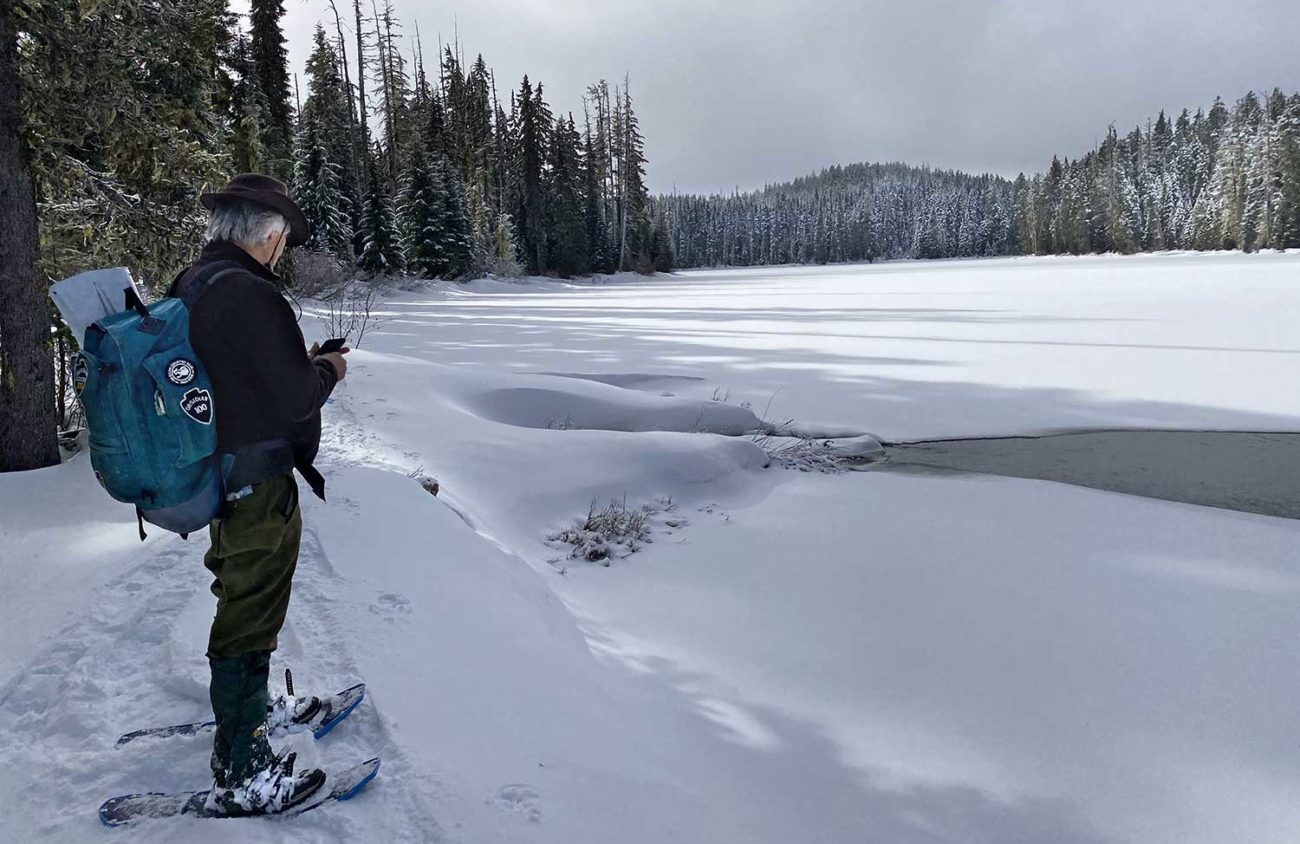Don’t succumb to cabin fever, even if the weather’s gloomy and your favorite mountain trails are buried under snow. Here’s an easy hike you can still do — on snowshoes.
I hear some of you saying that you’ve never snowshoed. Trust me, if you can walk, you can snowshoe. It’s like wearing clown shoes. A little awkward at first, but safe. You don’t slide out of control or fall down, as skiers often do. You can even wear your ordinary summer hiking boots.The only trick is that you can’t walk backwards. If you want to turn around, tromp in a circle.
Got it? Then rent a pair of snowshoes — they’re much, much cheaper than ski gear — and let’s go.
Oh, and buy a Sno-Park permit for your car. They’re $5 a day at outdoor stores.
If you’re uncertain about snowshoeing, a good first trip might take you to the Marilyn Lakes, two cute forest-rimmed lakes near Willamette Pass. The trail to the lakes is open year-round, but no one seems to notice it in summer because it’s too easy. In winter, a loop continues to a rustic shelter at Gold Lake and returns on a snowed-under road.
I recently snowshoed this route with Scott Hovis, one of the High Cascade Volunteers who maintains such trails in winter. Scott taught art at Cottage Grove High School for four decades — a daredevil occupation, in my estimation. Now he snowshoes to Salt Creek Falls every few weeks to check on things, picking up trash and replacing damaged trail signs. His loop is not for beginners because it skirts 300-foot cliffs beside the state’s second-tallest waterfall.
Scott suggested the easier tour to the Marilyn Lakes and Gold Lake, following a trail maintained by a different volunteer.
To try it yourself, drive to the Gold Lake Sno-Park, half a mile west of the Willamette Pass ski area on Highway 58. At the parking lot you’ll find a log cabin where volunteers offer hot chocolate and free maps.
The hardest part of the trip is walking across busy Highway 58 from the parking area. Then put on your snowshoes and set out on a gated, snowy road. After 0.2 miles, watch for a blue trail signboard to the left marking the Marilyn Lakes loop.
Because this wasn’t Scott’s own trail, he judged the maintenance with an expert eye. “Lots of blue diamonds,” he said. “Good.”
Apparently, you are supposed to be able to see one of these plastic markers in front of you and one behind you at all times. Sometimes we could see two ahead. If the trail turns sharply, even more markers are required, with black arrows. The Forest Service provides a supply of markers and trail signs, but volunteers have to nail them up. In summer, they have to carry a narrow, lightweight six-foot ladder to nail markers above the winter snow depth.
“Do you need first aid training to volunteer?” I asked.
“Some, yes.”
“Sensitivity training?”
“Not so much.”
The half-mile trail down to the Marilyn Lakes is not heavily used, so you might really need to watch for the blue markers along the way. After visiting one arm of the lower lake, you cross between the two lakes and follow the upper lake’s shore 0.3 miles to its inlet creek. Here you get a view of Diamond Peak, a distant snowy ridge just above the trees at the far end of the lake.
Continue on the loop trail from the Marilyn Lakes 0.3 miles to the snowed-under Gold Lake Campground. Here you’ll find a shake-sided shelter with a wood stove. Overnight camping is no longer allowed inside the shelter, apparently because people burned up too much firewood in the vain attempt to heat the place. You can’t heat an open-sided shelter.
Before heading back on the snowed-under Gold Lake Road — the easy way back to your car — detour north a stone’s throw to the lakeshore campground. Tables here are buried under white blocks of snow. A mile to the north, the far shore of Gold Lake looks like a low line of trees — but it’s actually Gold Lake Bog, a sphagnum marsh that’s only possible to explore in winter, when it’s frozen. That’s a trip for another day.
Hiking on snow is therapy, not just for muscles but for the wearied brain. When Hovis and I were driving up to the trailhead we talked about war, family problems and work. Those earnest subjects never came up while we were actually snowshoeing. And on the drive back we laughed about all kinds of silly memories.
The Marilyn Lakes are calling, even in winter. It’s time to get out of town.
William L. Sulllivan is the author of 23 books, including The Ship in the Woods and the updated 100 Hikes series for Oregon. Learn more at OregonHiking.com.

